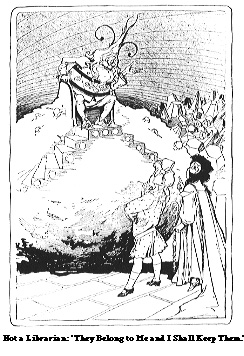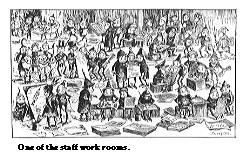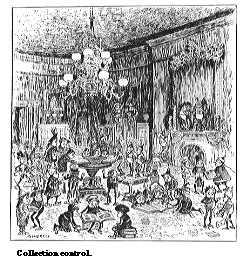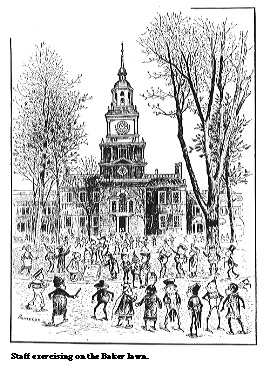Dartmouth College Library Bulletin
The Kingdom of Virtuous Acquisition
INTRODUCTION
On 6 May 1994, it was my privilege to be part of a celebration of the two-millionth acquisition by Dartmouth College Library, and to make some remarks at a luncheon largely attended by Library staff. In those remarks, which I summarize below, I discussed what was, to the eyes of a faculty member, an intriguing mystery about Library services and staff behavior. Since that pleasant afternoon I have continued to muse on the mystery, but have only very recently stumbled across its solution--which I am now prepared to reveal.
May these revelations reassure and refresh all faculty members, and may I suffer no retribution from staff for uncovering what has been an almost perfectly kept secret since at least 1892!
REMARKS AND RUMINATIONS
It seems to me entirely a wonderful thing that the symbolic two-millionth acquisition of Dartmouth College Library should be the Edward P. Sine '51 Collection of British Illustrated Books, for I am filled with wonder to see that an 'acquisition' actually contains six thousand illustrated volumes and three thousand original works of art. Clearly, I said to myself, librarians neither speak nor count like ordinary mortals. This was the first breath of the uncanny that brushed across the hairs on the back of my neck.
I began to ponder what else here was unusual and needed further consideration. There was the word, 'acquisition.' Normally, acquisitiveness is not considered a virtue; indeed, it belongs to those vices of a material world from which the quiet and holy zones of the library are totally removed. But if nine thousand items could be considered a single acquisition, could acquisition itself in the lexicon of the library be something noble, something virtuous? Could one pass through the Looking Glass with a word like that and, like Humpty Dumpty, make it mean what one wanted it to mean? This again seemed a bit uncanny.
In a trance of wonderment, perhaps inspired by Lewis Carroll, I tried to think where in books one might find vivid examples of acquisitiveness, the expansion of collections. And as I mused on Baker Library, I remembered that the original title of Alice In Wonderland had been Alice's Adventures Underground--and was there not a clue here? I could think of several kinds of creatures, all imaginary, I thought, who lived underground and were acquisitive. From my childhood I recalled the Oz books, and especially the Nome King, King Roquat of the Rocks. This is how Princess Ozma describes him:
He is said to be the Ruler of the Underground World, and commands the rocks and all that the rocks contain. Under his rule are many thousands of the Nomes, who are queerly shaped but powerful sprites that labor at the furnaces and forges of their king, making gold and silver and other metals which they conceal in the crevices of the rocks. . . . Also they make diamonds and rubies and emeralds, which they hide in the ground.[1]
But the Nome King, even though he looks like a mineralized Santa Claus, turns out to be not a very pleasant fellow--acquisitive but not a bit noble, unwilling to lose any of his treasures or even give back what he had stolen. Only in their fantasies would librarians like to say what King Roquat says here.
Then I thought of the dwarves in Tolkien's Lord of the Rings. They were grand artificers and geniuses of the forge. Their underground dwellings were vast and gorgeously constructed caverns, rich in treasures and inventions. If it was true that the dwarves preferred to make material things, and to dwell out of the light of day, it was also true that they proved faithful and heroic allies, stout warriors against the real powers of Darkness and the evil Sauron. One could say that such dwarves were noble even as they were acquisitive. Yet there was no record that they had anything in particular to do with books.

Still, I felt I was going in the right directon, and this pointed underground. Now some other mysteries I had noted at random began to interconnect. To begin with, I realized that most faculty members have a very sketchy idea of the acquisition process. We are told that the Library gathers about 35,000 acquisitions a year. The Library is adding, then, an average of 135 acquisitions each (working) day. Even assuming they are not multiple entries like the Sine Collection, where do they all go, where do they get placed? Has anyone witnessed a stream of 135 packages entering at any entrance--and this, every day? Yet new books regularly appear on display, and show up on the shelves. The Library seems full-to-bursting already.
To be sure, the faculty member thinks the answer is plain: we are in steady-state, the surplus goes to Storage (out on Route 120): as 135 new books stream in, 135 old books stream out. And yet such daily processions have not been witnessed. Furthermore, it is also clear that 'Storage' is a building of modest dimensions with its own limited space. It begins to seem that our Library's spaces are indeed Virtual, that they may well extend into uncanny dimensions. For example, it may be an elvish joke on the Library's part to speak of 'Overflow,' a category suggesting additional space. Yet these overflow spaces are (presumably) in this same Baker building that is already full-to-bursting. Perhaps 'overflow' is somewhere else?
When one thinks hard about the matter, it is uncanny to realize how many bibliotopic hints brush past the unheeding users as they travel about the building. There are certain signs indicating that books travel to faraway sites, exotically named--Paddock, Dana, Feldberg, Kresge, Sherman--and then return; but has anyone seen little trucks with, say, 'Feldberg' on the side, backing up to the loading dock? There is more here than meets the eye. Equally mysterious is the related process of interlibrary loans: one is told that a book does not exist in our collection, but can be borrowed. Now, has anyone seen a truck labeled 'Harvard University Library,' or, for that matter, 'Pismo Beach Public Library,' backing up to the loading dock? I think not. It seems not to have occurred to the normal user that Baker Library might, indeed, have these volumes, but retrieve them from Virtual, or (let's be accurate) Uncanny Space.
A possible key to the mystery lies in the itineraries of the humble library cart. Certainly one sees carts everywhere, loaded with books. But exactly how many are there? Their number could be in the scores to be sure, even in the hundreds--but suppose they were in the hundreds of thousands? And just where do they go? Until some daring adventurer manages to band a selected sample, like migratory birds, we will have no way of knowing just what we are seeing, and the magical may continue to appear humdrum.
I wondered for a time if the enormous serpentines of the new 'steam tunnels,' finished just a short while ago and clearly connecting to Baker Library, might be some audacious major connection to these uncanny spaces. Did I not remember that an engineering student from Thayer School once demonstrated that a huge storage space could be built underneath the Baker lawn, i.e., immediately south of the main entrance? And was it not true that his report was suppressed (Lord knows what happened to him) and we were all supplied with the answer that tree roots were too long, the water table too high for such excavation? Perhaps the space already exists?
How does one discover such a space? Several possibilities--in plain sight, as it were, but not heeded--suggest themselves. First of all, consider the staff staircase in the middle of the building. No living faculty member has ascended that staircase--or more accurately, none has gone up the staircase and come back down alive. And consider (the surely connected) phenomenon of 'M' among the elevator buttons--which, indeed, has no regular button, but only a place for a key--which no living faculty member possesses. My son, who graduated from Dartmouth in 1978, worked for the Library and tried to explain to me that there were simply work spaces up there, a floor not of book stacks but of tables and desks, twine and glue. Yet when I asked him what he did on such a floor, he told me he was 'Gaylording.' Well. It was obvious he was pulling my leg, and I did not dignify his filial mischief with further inquiry. He said 'M' stood for mezzanine, but might it not stand, instead, for Magicians? Here I was recalling that elusive figure, seen disappearing around a distant stack, clad in white coveralls, wearing a helmet and a yellow flashlight, muttering (or so I thought I overheard) about his 'Stack Elves.'
Elves? Could that be it? The questions kept leading back underground. And on two occasions I thought I was next door, so to speak, to the answer. One afternoon while in the stacks, I heard distant sounds of merriment, light voices caroling, dishes clinking. But I could see nothing unusual. It seemed to come from the other side of some locked doors that were at the side of the stacks--I was reminded of Alice's attempts to discover the tea party, and how she had to shrink, finally, to gain entry.
On another day, I went to the very depths of the Library--or so I thought. I was on the first floor, in the annex to the stacks, between aisle 58 and 59. It was very dim and dark, but I realized that in the floor was a curious slab, or cap, of concrete, set across so as to interrupt the normal vinyl squares of the corridor. (It is there--go see for yourselves.) It was six foot wide by north-south, twenty inches wide by east-west. Set into it on each side were two pivoting metal rings. It was clearly a slab to be lifted up . . . but not by any mortal user I could imagine. A tentative tug at the rings brought only a pain to the shoulder, accompanied by a sound that was either a silvery chuckle out of the shadows at the other end of the floor, or a sigh from the heating system.
This was the most uncanny moment of all. Was I not on the very limen, the threshhold of the Library's secret space? Were there not vast caverns below me with every book imaginable which could, after varied and appropriate passages of time, be fetched me by what were (in their original form) Library elves?
I never discovered more, of course, and the mystery remains. But the fact of the matter is this: that the very foundation of our Library's greatness and graciousness is Underground--taken literally or metaphorically; and that making user services possible is a prodigious battalion, literally or metaphorically, of inexhaustible Library elves who traverse that infinite region, the Kingdom of Virtuous Acquisition, with efficiency and joy.
THE SECRET OF THE BROWNIES

Up to this point, then, the substance of my remarks in May 1994. I smile now to see how close to the truth--yet how far!--I was at the time. You will notice me hedging my bets there, with 'literally or metaphorically.' The whole thing, I must confess, sounds a bit wispy. But now I can announce a new discovery which takes my theories out of the land of fantasy and even, with the right interpretation, provides visual confirmation of the imagination's surmise.

Actually, as a small boy I had discovered a book about the Brownies in my
aunt's library. But it was the acquisition of the Sine Collection that revived
that memory and sent me to Special Collections to re-examine what had once
seemed fantasy and now seemed documentary. The Brownies were the invention (or
as I now prefer to say, the discovery) of Palmer Cox in the late nineteenth
century--a sort of proto-Dr. Seuss with his wild tales, his comic spirit, his
doggerel, and his entertaining illustrations. I leaved through (with new eyes)
our copy of his The Brownies at Home. This is how he describes them:

Brownies . . . are imaginary little sprites, who are supposed to delight in harmless pranks and helpful deeds. They work and sport while weary households sleep, and never allow themselves to be seen by mortal eyes.[2]
So far, so good. Cox seemed to think these had a Scottish origin, and certainly the Puck-like creatures have a lineage that extends very far back in time. But I looked at his pages and the above description after I had been puzzling over the question of 'library elves,' and his words took on new meanings. How 'imaginary' were they, in fact? The 'harmless pranks' were easily identified with such harmless teases as Gaylording and 'Storage'; more important was 'helpful deeds.' That rang very true. That they were nocturnal comported with the legends of elves, but I wondered if Cox perhaps missed a little bit at that point. That they worked at night was certainly possible, and at such times they might, indeed, be out of mortal sight; but it was possible that during the day they had the aspect of Librarians.

Cox never quite got to that realization, at least in the words he wrote. But his illustrations seemed to reach towards a truth even beyond his conscious recognition. After looking at some of his illustrations, an astounding possibility occurred to me. Look now at the first example, on page 73. Cox's book was published in 1892, so it cannot possibly describe the spaces of Baker Library, which dates from 1929. Nevertheless, Dartmouth's first library was in Wilson Hall, dating from 1883. Could it not be possible that the first library staff at Dartmouth was so uncanny, so magically serviceable, that tales of its prowess spread over the land? and that Palmer Cox, hearing of these, wove them into ostensible fiction? That would explain this first picture, which purports to show the Brownies at work constructing Valentines, but which even more clearly shows Librarians hard (but happily) at work in both practical and creative ways.

Or turn to the second example, on page 74. Once again, Palmer Cox has slightly trivialized a very serious operation and turned it into an adventure in the White House; yet it seems much more likely that the core of this story lies in the very professional duties of the curatorial staff, beginning with a basic love of books and extending to their inspection and preservation (you can see one worker preparing to slit some uncut leaves, while another exclaims over a defective binding, and still another inventories some illustrations): 'The volumes there the Brownies found/ From hand to hand were passed around.'[3]

The important part about all this is that Palmer Cox apparently heard accounts of the unobtrusive services of Dartmouth librarians and turned them into the pranks and secret activities of an elvish race. With hindsight, we can reinterpret his fanciful interpretations and discover a documentary reality. Confirmed here are matters of staff specialization, adequacy of personnel, and great variety of talents and backgrounds. The Brownies, as it were, are a teeming crew setting about on serious work with a sense of play. Cox imagines them traveling all over the United States (and indeed, all over the world), but it is not hard to deduce where they came from: they come from the ground under us, homing to the smells of ink and library paste.

The most astonishing, most conclusive, and, indeed, most visionary illustration is this last one from Cox, on page 75. In his fancy, Cox has taken his Brownies, he thinks, to Philadelphia, but the careful modern reader can see that he has limned more than he could imagine: it is as if there had been a time-warp, and the author of 1892 suddenly had a vision of post-1929. For there can be no doubt about it: here are our Library elves, probably under the light of a full moon in the wee small hours of the morning, taking a break from their labors.

So there you have it: we are indebted to a species of elves who help us graciously and only a little mischievously (generally suppressing their smiles); who do more work unseen than when seen, and usually at night; who traffic in an unimaginable plenitude of books, all kept gleaming bright and clean in what may well be ten or twenty more stories beneath the level of present annex-level one (and for that matter, quite possibly extending under most of the main campus, interconnected by the steam tunnels through which run endless processions of mystic carts).

The only sad thing is that we can never really thank them adequately, for to let Library elves know you know their secret is to risk their disappearance and replacement by descendants of King Roquat. Walk quietly and carefully, then, be happy with the favors you receive, and never, ever get off the elevator at letter 'M.'

A NOTE ON THE ILLUSTRATIONS
The King Roquat illustration is taken from L. Frank Baum, Ozma of Oz, illustrated by John R. Neill (Chicago: The Reilly & Lee Co., 1897), p. 167. The three large Brownie illustrations are taken from Palmer Cox, The Brownies at Home (New York: The Century Co., 1892), pp. 16, 32, and 88, respectively. The Brownie on the cover and those sprinkled throughout the text are original drawings by Palmer Cox prepared for The Brownies through the Union (New York: The Century Co., 1895). These Brownies usually reside in Special Collections where they were a gift of the Friends of the Library.
2.Palmer Cox, The Brownies at Home (New York: The Century Co., 1892), vii.
3.Cox, Brownies at Home, 34.